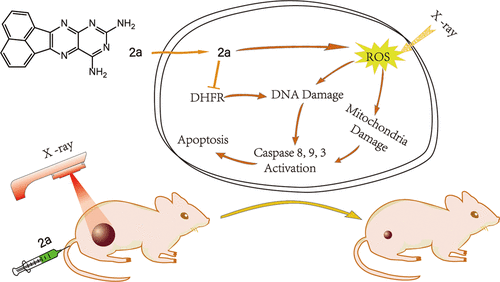当前位置:
X-MOL 学术
›
ACS Med. Chem. Lett.
›
论文详情
Our official English website, www.x-mol.net, welcomes your
feedback! (Note: you will need to create a separate account there.)
Designing Dihydrofolate Reductase Inhibitors as X-ray Radiosensitizers to Reverse Radioresistance of Cervical Cancer.
ACS Medicinal Chemistry Letters ( IF 3.5 ) Pub Date : 2020-06-17 , DOI: 10.1021/acsmedchemlett.0c00105 Yuanwei Liang 1 , Delong Zeng 1 , Yuanyuan You 1, 2 , Bin Ma 1 , Xiaoling Li 1, 3 , Tianfeng Chen 1
ACS Medicinal Chemistry Letters ( IF 3.5 ) Pub Date : 2020-06-17 , DOI: 10.1021/acsmedchemlett.0c00105 Yuanwei Liang 1 , Delong Zeng 1 , Yuanyuan You 1, 2 , Bin Ma 1 , Xiaoling Li 1, 3 , Tianfeng Chen 1
Affiliation

|
X-ray radiotherapy has been widely used in the treatment of cervical cancer, a common gynecologic malignant tumor. However, the therapeutic efficacy tends to be indistinctive. One major reason for this is amplification of the dihydrofolate reductase (DHFR) gene, which causes an increase in DHFR activity and attenuation of the treatment effect. To solve this problem, we synthesized a series of DHFR inhibitors derived from methotrexate (MTX) analogues as radiotherapy sensitizers. Activity screening revealed that compound 2a exerted the best inhibitory effect toward DHFR activity. In combination with X-ray radiotherapy (4 Gy), 2a showed much more prominent antiproliferative activity on cervical cancer cells than 2a or X-rays alone and revealed higher selectivity and radiosensitization than MTX. In vitro experiments showed that 2a + X-rays significantly induced cell apoptosis, as revealed by the increase in the Sub-G1 population and activation of caspase 3, 8, and 9. The in vivo antitumor effect demonstrated that in the presence of X-rays, 2a effectively suppressed tumor growth and did not cause obvious side effects. In conclusion, as a DHFR inhibitor, 2a successfully reversed the radioresistance problem induced by radiotherapy and greatly promoted the therapeutic effect. This is a promising candidate for tumor treatment that deserves further research and development. This study clearly demonstrates that DHFR inhibitors could be developed as promising radiosensitizers in the treatment of cervical cancer and that further research to improve their activity and potential in future clinical use is deserved.
中文翻译:

设计二氢叶酸还原酶抑制剂作为X射线放射增敏剂以逆转宫颈癌的放射抗性。
X射线放射疗法已被广泛用于宫颈癌的治疗,宫颈癌是一种常见的妇科恶性肿瘤。但是,治疗效果往往不明显。其主要原因之一是二氢叶酸还原酶(DHFR)基因的扩增,这导致DHFR活性增加和治疗效果减弱。为了解决这个问题,我们合成了一系列从甲氨蝶呤(MTX)类似物衍生的DHFR抑制剂作为放射治疗敏化剂。活性筛选表明,化合物2a对DHFR活性具有最佳的抑制作用。结合X射线放射疗法(4 Gy),2a对宫颈癌细胞的抗增殖活性比2a更为显着或单独使用X射线,显示出比MTX更高的选择性和放射敏感性。体外实验表明2a + X射线可显着诱导细胞凋亡,这由Sub-G1群体的增加以及caspase 3、8和9的激活所揭示。体内抗肿瘤作用表明存在X-射线2a有效地抑制了肿瘤的生长,并且没有引起明显的副作用。总之,作为DHFR抑制剂,2a成功地逆转了放疗引起的放射抵抗问题,大大提高了治疗效果。这是肿瘤治疗的有希望的候选者,值得进一步研究和开发。这项研究清楚地表明,DHFR抑制剂可以作为治疗宫颈癌的有希望的放射增敏剂而开发,值得进一步研究以提高其活性和未来临床应用的潜力。
更新日期:2020-07-09
中文翻译:

设计二氢叶酸还原酶抑制剂作为X射线放射增敏剂以逆转宫颈癌的放射抗性。
X射线放射疗法已被广泛用于宫颈癌的治疗,宫颈癌是一种常见的妇科恶性肿瘤。但是,治疗效果往往不明显。其主要原因之一是二氢叶酸还原酶(DHFR)基因的扩增,这导致DHFR活性增加和治疗效果减弱。为了解决这个问题,我们合成了一系列从甲氨蝶呤(MTX)类似物衍生的DHFR抑制剂作为放射治疗敏化剂。活性筛选表明,化合物2a对DHFR活性具有最佳的抑制作用。结合X射线放射疗法(4 Gy),2a对宫颈癌细胞的抗增殖活性比2a更为显着或单独使用X射线,显示出比MTX更高的选择性和放射敏感性。体外实验表明2a + X射线可显着诱导细胞凋亡,这由Sub-G1群体的增加以及caspase 3、8和9的激活所揭示。体内抗肿瘤作用表明存在X-射线2a有效地抑制了肿瘤的生长,并且没有引起明显的副作用。总之,作为DHFR抑制剂,2a成功地逆转了放疗引起的放射抵抗问题,大大提高了治疗效果。这是肿瘤治疗的有希望的候选者,值得进一步研究和开发。这项研究清楚地表明,DHFR抑制剂可以作为治疗宫颈癌的有希望的放射增敏剂而开发,值得进一步研究以提高其活性和未来临床应用的潜力。











































 京公网安备 11010802027423号
京公网安备 11010802027423号